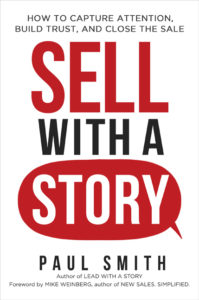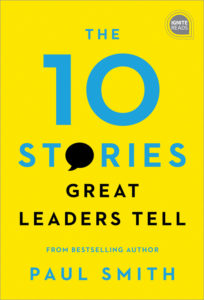Podcast: Play in new window | Download | Embed
Subscribe: RSS
Podcast (sell-with-a-story-series1): Play in new window | Download | Embed
Subscribe: RSS

{#21 in a series of the 25 Most Useful Sales Stories, from Sell with a Story}
Every salesperson worth their salt does their best to get in front of the ultimate decision-maker. But we all know that’s not always possible. Usually, that’s because the decision is being made too far up the hierarchy for the salesperson to get access (like by the president or CEO or even the Board of Directors).
When that’s the case, good salespeople find an internal sponsor to champion their cause. Then they arm that sponsor with all the information they need to make the sale on their behalf.
But the more creative salespeople also include a story. And they do that because they know the story is more likely to be remembered and repeated in the meeting than the sales pitch. Nobody wants to sound like a shill for a supplier. But they do want to sound insightful, and that’s what the story does for them (and you).
 They also know a story is their most reliable way to inspire the sponsor with a similar sense of passion for the cause. Here’s an example of what that might look like from Tia Finn, global learning specialist at the publishing and education company, Pearson PLC, in London.
They also know a story is their most reliable way to inspire the sponsor with a similar sense of passion for the cause. Here’s an example of what that might look like from Tia Finn, global learning specialist at the publishing and education company, Pearson PLC, in London.
Arming Your Sponsor
One of the things you learn quickly when you’re selling textbooks and other educational solutions to schools is that the final decision is often made by the school board in a closed session.
In those situations, Tia likes to tell a “future state” or “feeling” story. Let’s say she’s talking to the superintendent of a struggling school district. The district’s biggest problem is that the students aren’t making the minimum scores on standardized tests to get into college. Tia has two programs she knows can help, and she’s already showed the superintendent all the data documenting the results. She’s hoping he’ll represent those two programs on her behalf at the next school board meeting.
In her last meeting with the superintendent prior to the board meeting, she might say something like this:
I really wish you could meet Mary Lou at Rover High School across town. You’re familiar with that school, right? Well, she’s just like you. Her students are very similar to yours, and they’re struggling with the exact same issues. In fact, they’ve been facing it longer than you—more than a decade. Well, I got a call from her a few weeks ago and she said, “Tia, you won’t believe it! Go get a copy of today’s newspaper. There’s an article about our school!” She was so excited.
Then she told me about the article. “It showed our newest test scores, and they’re amazing! We’re up fifteen percent since last year, and we had sixty more students placed in colleges. The programs you helped us put in place in the fall are really working. This is the biggest news about our school in a decade!”
Then Tia closes the story by asking this question: “Would you like to be able to make that phone call a year from now?”
The answer, of course, is always a resounding yes. And it sends her champion off to the school board meeting with an inspired purpose and a story to tell.
Why it works
But why does such a simple story work so well? After all, it’s less than 170 words long and can be told in about a minute. How is this story any different from just telling the prospect about the results at Rover High School—the fifteen percent increase in scores and the sixty additional college admissions?
 The answer is that the story isn’t about the test scores and college admissions. The story is about Mary Lou and how those results made her feel. You can feel the excitement in her voice and her pride in the newspaper article and the accomplishments of her students.
The answer is that the story isn’t about the test scores and college admissions. The story is about Mary Lou and how those results made her feel. You can feel the excitement in her voice and her pride in the newspaper article and the accomplishments of her students.
Tia knows people don’t buy a car because they’re infatuated with the car. They buy a car because of how it makes them feel. It’s the same with just about everything else. Tia’s not just selling education programs. She’s selling excitement and pride and accomplishment. And that’s why Tia calls this a “feeling story.” It’s about how her programs make the customer feel.
Tia believes the key to having a great “feeling story” is the phrase “just like you.” This makes the hero in the story relatable to the audience. If her prospect is a poor, rural school district struggling with elementary reading levels, telling them about a wealthy suburban school struggling with college readiness is not going to make a good story.
Next Steps
To capture this kind of story, you might need to interview some of your better customers. Ask them to tell you about the moment that your product or service really started to feel like a success. Was it the aha moment when a report landed on their desk showing improved productivity? Was it when they got a call from their boss congratulating them on their good numbers? Was it when they received a department award? Or was it a simple smile from the production crew chief when he said he wouldn’t have to work this weekend because the new machines were working more reliably than the old ones?
Keep digging until you get to a real feeling worthy of building a story around.
Click these links to subscribe to this podcast on iTunes or Stitcher, or Podbean.
Source: Sell with a Story: How to Capture Attention, Build Trust, and Close the Sale, by Paul Smith.
—
 Paul Smith is one of the world’s leading experts on business storytelling. He’s a keynote speaker, storytelling coach, and bestselling author.
Paul Smith is one of the world’s leading experts on business storytelling. He’s a keynote speaker, storytelling coach, and bestselling author.
Connect with him via email here. Follow him on Facebook, LinkedIn, and Twitter.
Sign up for his newsletter here to get one new story a week delivered to your inbox.
 |
 |
 |
 |
 |

